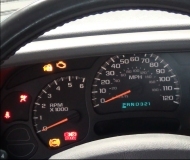Hi:
If there is no spark and you replaced the crank and cam sensors, my next suspect is the ignition control module. The module is under the three coils. The ICM is responsible for the following:
___________________________________________
Ignition control module (ICM) and ignition coils
Three dual tower ignition coils are mounted to the ICM, and are serviced individually. The ICM performs the following functions:
- The ICM receives and processes the signals from the CKP sensor B.
- The ICM determines the correct direction of the crankshaft rotation, and cuts spark and fuel delivery to prevent damage from backfiring if reverse rotation is detected.
- The ICM determines the correct coil triggering sequence, based on the 7X CKP signal. This coil sequencing occurs at start-up, and is remembered by the ICM. After the engine is running, the ICM will continue to trigger the coils in the correct sequence.
- The ICM produces and inputs 3X reference signals to the PCM.
- The ICM contains the coil driver circuits that command the coils to operate.
___________________________________________
Now, what I suggest is to remove the module and have it tested. Most nationally recognized parts stores are able to do this and will for free.
___________________________________________
Here are the directions for removal and replacement. However, in addition to this, I strongly recommend having the converter issue resolved. If it is plugging, it will cause power loss and can cause internal engine damage.
__________________________________________
2003 Pontiac Grand AM V6-3.4L VIN E
Procedures
Vehicle Powertrain Management Relays and Modules - Powertrain Management Relays and Modules - Ignition System Ignition Control Module Service and Repair Procedures
PROCEDURES
REMOVAL PROCEDURE
pic 1
1. Disconnect all the electrical connectors at the ignition control module.
2. Note position of spark plug wires for installation and disconnect the spark plug wires from ignition coils.
3. Remove the screws securing coil assemblies to ignition control module.
4. Disconnect the coils from ignition control module.
5. Remove the ignition control module from the bracket.
INSTALLATION PROCEDURE
1. Install the ignition control module on the bracket.
Pic 2
2. Install the coils to ignition control module.
3. Install the screws.
NOTE: Refer to Fastener Notice in Service Precautions.
Tighten
Tighten the screws to 4.5 N.M (40 lb in).
4. Connect the spark plug wires as noted during removal.
5. Connect the electrical connectors to the ignition control module.
_____________________________________________________
Let me know what you find or if you have other questions.
Take care,
Joe
Images (Click to make bigger)
Sunday, November 17th, 2019 AT 8:13 PM








